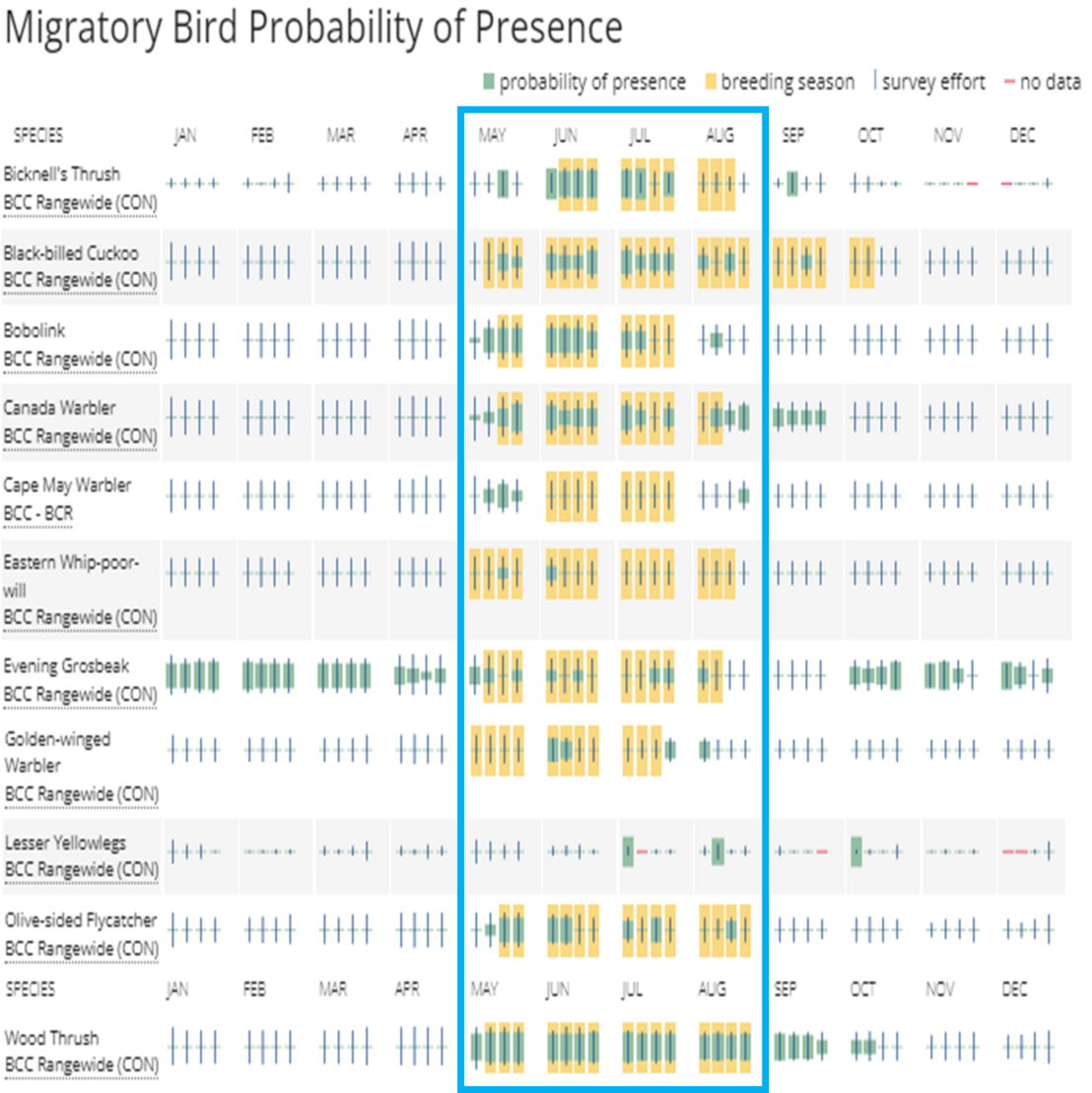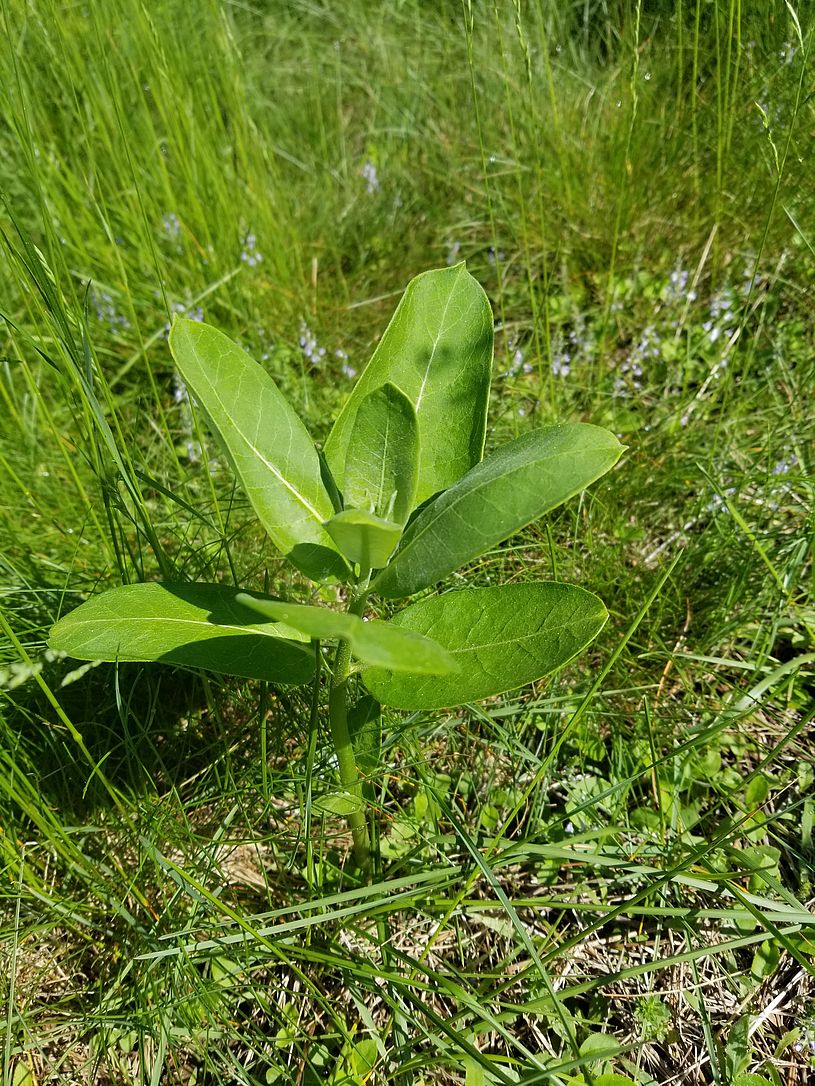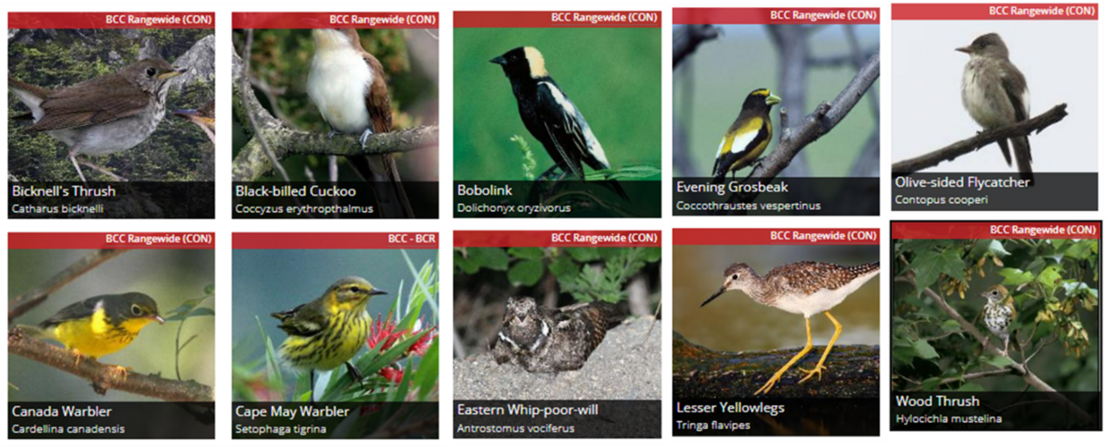You Have Guests in Your Backyard—how will you host them?
Everytime you walk out the door in Vermont you hear the seasonal visitors. So far this spring, BirdCast has projected that 70 million birds have flown over our Vermont landscape in search of a place to nest and rear their young. A mind-blowing amount of potential ‘visitors’, and quite the opportuity for us to appeal to their senses - whether they decide to stay or if they just need a stopover. And birds are not the only migrators; we will also host Northern Long-Eared Bats bats and Monarch Butterflies this migratory season.
The U.S. Fish & Wildlife department offers a tool to identify species of concern due to their current low populations. Called IPaC – Information for Planning and Consultation, the tool is amazingly easy to use, whether for an environmental review project or for a curious landowner or naturalist. In figure one, you will see the ten bird species that are mapped in the current Cold Hollow to Canada geographic area; all of the birds listed here have been identified as, “Birds of Conservation Concern (BCC)”. They are identified because without additional conservation actions, they are possible candidates for listing under the Endangered Species Act (ESA) of 1973 (IPaC, 2022). Anyone can access the IPaC site, choose, “get started” and define your area of interest (not all the birds listed here will be mapped in a smaller targeted area).
You are hosts to the seasonal visitors! By mindfully managing in a wildlife centric way you can absolutely minimize stressors and prevent population reduction from nesting disturbance (US FWS, 2015):
- Avoid work in the woods: schedule all vegetation removal, trimming, and grading of vegetated areas outside of the peak bird breeding season to the maximum extent practicable.
- Prevent increase in lighting of native habitats during the bird breeding season.
- Minimize prolonged human presence near nesting birds during construction and maintenance actions.
- Prevent the increase in noise above ambient levels during the nesting bird breeding season.
- Prevent the introduction of chemicals contaminants into the environment.
How do we know when they peak nesting season is happening? From the species mapped above, we can look at their ‘probablilty of presence’ to see when they are here and likely nesting (majority are May through August). The timeframe outlined below also overlaps with the roosting season for the Northern Long Eared Bat (listed federally as ‘Threatened’). They form colonies and roost under tree bark, in cavities or in crevices. If there are roosting bats in a tree that is cut and dropped onto the forest floor, they do not have the capacity to fly off the ground (they have to drop from a hanging position into flight), which make them very susceptible to tree harvests during the roosting period.

As we know, birds may move and utilize adjacent landscapes for feeding or they may have a preference to nest in the field, like the beloved Bobolink. Multiple studies have brought up a no-mow or delayed mowing approach. There are different methods to reduce impacts to nesting birds, which all depends on your goal for how to manage it. Maximize hay production? Consider starting your mowing in the middle of the field and cut towards the outer perimeter, anything bedding down may have a chance to fledge the field. Try to balance hay quality while balancing out the nesting season? Take the 1st cut for high quality as soon as field conditions allow and then forego the next cut for 65 days from the last cut. If you do not manage for production, but enjoy walking the field try a mosaic pattern to create a walking trail but not the entire field (this can also initiate a labyrinth-like pattern in your field if habitat structure appeals to you). Want to maximize the field for wildlife usage? Don’t abide by any of these dates, allow the field to grow as long as possible and cut just before the seasonal high-water table comes back (typically when the trees drop their leaves and stop sucking water from the ground) to prevent compaction and ruts. This last option ensures maximum time for nesting birds, pollinators, and insects to utilize the field—if your field has an erosive tendency this will also sequester more roots to reduce erosion. Caveat to all of these - if you know you have invasives in your field, most of these plants need to be mowed to reduce spread. If you do have invasives (spotted knapweed, poison parsnip, etc.) it would be best to make your goal controlling these and wildlife goals secondary, because they make for poor habitat and spread rapidly through the community.

When pulling up the IPaC mapping for Cold Hollow to Canada, the Monarch Butterfly was also noted. They have been categorically determined to be a ‘Candidate’. A species under consideration for official listing for which there is sufficient information to support listing. One of the easiest ways to support Monarchs is to not mow the milkweed – there are initiatives to plant milkweed, but they can be a very hard plant to establish. However, if you want to give it a try, plant common milkweed in a high-dry spot with little grass competition. There are also variations of milkweed, like swamp milkweed, which will prefer wet areas. If you plant it, make sure to smell the flowers(!)-- there is nothing like the ‘Eau de Parfum’ of Swamp Milkweed. Heads up! In case you had not heard there is the ‘insect’s harvest’ happening in late September/early October, you can glimpse it in a goldenrod field – an ecological abundance that has yet to be measured. Bees, ants, spiders – oh my!
We have all felt it, that invitation from our visitors to slow down and take in the abundance around us, perhaps you have felt yourself as a guest at this party in the woods. Summer can feel fleeting and amazing while here and we are not the only ones enjoying it. We are a host to many seasonal visitors and we can be really accommodating if we understand what our guests need during their stay.
References:
Line, Les, and November-December 2009. “Buying Time.” Audubon, 13 Apr. 2016, www.audubon.org/magazine/november-december-2009/buying-time.
US Fish and Wildlife Service. “Information for Planning and Consultation.” IPaC, ipac.ecosphere.fws.gov/location/WTF53FPB5VD7FFFCZL3LXZ42E4/resources.
US Fish and Wildlife Service. Nationwide Standard Conservation Measures. www.fws.gov/sites/default/files/documents/nationwide-standard-conservation-measures.pdf.
“Vermont - Birdcast Migration Dashboard.” BirdCast, dashboard.birdcast.info/region/US-VT.
